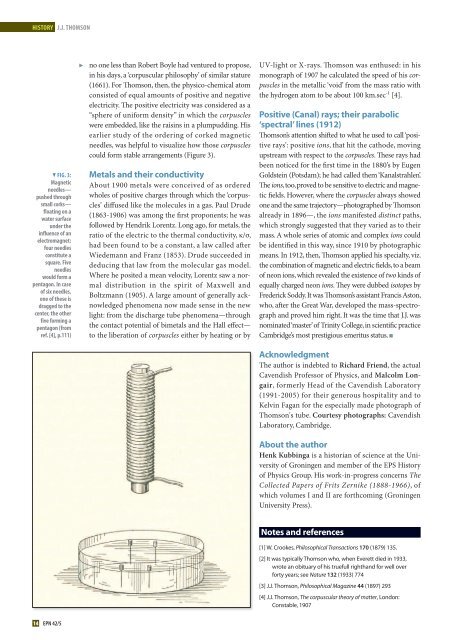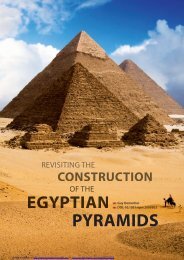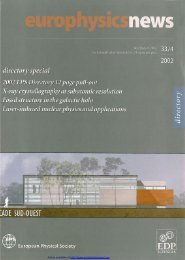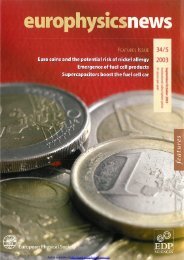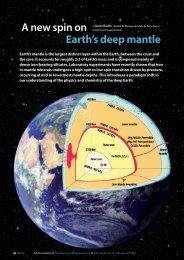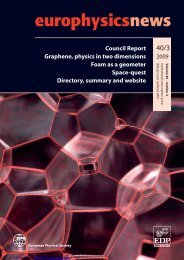PDF (11.37 MB) - Europhysics News
PDF (11.37 MB) - Europhysics News
PDF (11.37 MB) - Europhysics News
Create successful ePaper yourself
Turn your PDF publications into a flip-book with our unique Google optimized e-Paper software.
HiSTory J.J. THomSon<br />
� fig. 3:<br />
magnetic<br />
needles—<br />
pushed through<br />
small corks—<br />
floating on a<br />
water surface<br />
under the<br />
influence of an<br />
electromagnet:<br />
four needles<br />
constitute a<br />
square. five<br />
needles<br />
would form a<br />
pentagon. in case<br />
of six needles,<br />
one of these is<br />
dragged to the<br />
center, the other<br />
five forming a<br />
pentagon (from<br />
ref. [4], p.111)<br />
14 EPN 42/5<br />
�<br />
no one less than Robert Boyle had ventured to propose,<br />
in his days, a ‘corpuscular philosophy’ of similar stature<br />
(1661). For �omson, then, the physico-chemical atom<br />
consisted of equal amounts of positive and negative<br />
electricity. �e positive electricity was considered as a<br />
“sphere of uniform density” in which the corpuscles<br />
were embedded, like the raisins in a plumpudding. His<br />
earlier study of the ordering of corked magnetic<br />
needles, was helpful to visualize how those corpuscles<br />
could form stable arrangements (Figure 3).<br />
Metals and their conductivity<br />
About 1900 metals were conceived of as ordered<br />
wholes of positive charges through which the ‘corpuscles’<br />
diffused like the molecules in a gas. Paul Drude<br />
(1863-1906) was among the first proponents; he was<br />
followed by Hendrik Lorentz. Long ago, for metals, the<br />
ratio of the electric to the thermal conductivity, κ/σ,<br />
had been found to be a constant, a law called a�er<br />
Wiedemann and Franz (1853). Drude succeeded in<br />
deducing that law from the molecular gas model.<br />
Where he posited a mean velocity, Lorentz saw a normal<br />
distribution in the spirit of Maxwell and<br />
Boltzmann (1905). A large amount of generally acknowledged<br />
phenomena now made sense in the new<br />
light: from the discharge tube phenomena—through<br />
the contact potential of bimetals and the Hall effect—<br />
to the liberation of corpuscles either by heating or by<br />
UV-light or X-rays. �omson was enthused: in his<br />
monograph of 1907 he calculated the speed of his corpuscles<br />
in the metallic ‘void’ from the mass ratio with<br />
the hydrogen atom to be about 100 km.sec -1 [4].<br />
Positive (Canal) rays; their parabolic<br />
‘spectral’ lines (1912)<br />
�omson’s attention shi�ed to what he used to call ‘positive<br />
rays’: positive ions, that hit the cathode, moving<br />
upstream with respect to the corpuscles. �ese rays had<br />
been noticed for the first time in the 1880’s by Eugen<br />
Goldstein (Potsdam); he had called them ‘Kanalstrahlen’.<br />
�e ions,too,proved to be sensitive to electric and magnetic<br />
fields. However, where the corpuscles always showed<br />
one and the same trajectory—photographed by �omson<br />
already in 1896—, the ions manifested distinct paths,<br />
which strongly suggested that they varied as to their<br />
mass. A whole series of atomic and complex ions could<br />
be identified in this way, since 1910 by photographic<br />
means. In 1912, then, �omson applied his specialty, viz.<br />
the combination of magnetic and electric fields,to a beam<br />
of neon ions,which revealed the existence of two kinds of<br />
equally charged neon ions. �ey were dubbed isotopes by<br />
Frederick Soddy.It was �omson’s assistant FrancisAston,<br />
who, a�er the Great War, developed the mass-spectrograph<br />
and proved him right. It was the time that J.J. was<br />
nominated‘master’of Trinity College,in scientific practice<br />
Cambridge’s most prestigious emeritus status. ■<br />
Acknowledgment<br />
The author is indebted to Richard Friend, the actual<br />
Cavendish Professor of Physics, and Malcolm Longair,<br />
formerly Head of the Cavendish Laboratory<br />
(1991-2005) for their generous hospitality and to<br />
Kelvin Fagan for the especially made photograph of<br />
Thomson's tube. Courtesy photographs: Cavendish<br />
Laboratory, Cambridge.<br />
About the author<br />
Henk Kubbinga is a historian of science at the University<br />
of Groningen and member of the EPS History<br />
of Physics Group. His work-in-progress concerns The<br />
Collected Papers of Frits Zernike (1888-1966), of<br />
which volumes I and II are forthcoming (Groningen<br />
University Press).<br />
Notes and references<br />
[1] W. Crookes, Philosophical Transactions 170 (1879) 135.<br />
[2] It was typically Thomson who, when Everett died in 1933,<br />
wrote an obituary of his truefull righthand for well over<br />
forty years; see Nature 132 (1933) 774<br />
[3] J.J. Thomson, Philosophical Magazine 44 (1897) 293<br />
[4] J.J. Thomson, The corpuscular theory of matter, London:<br />
Constable, 1907


